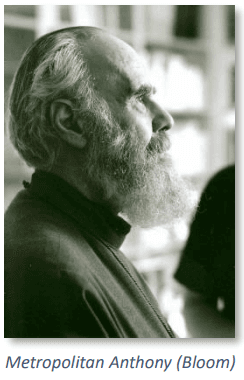An Introduction to Prayer
What is needed to experience the Kingdom of God, to receive the peace of Christ, and to interact faithfully and fruitfully with the world is a prayerful heart. It is perhaps significant that in the Divine Liturgy, even before the people begin to praise God in the antiphons, they lift up their voices in prayer in the Great Litany.
There are, of course, heights which can be reached in prayer only after many years— heights which are mostly reached by those with leisure and solitude to devote to prayer as an uninterrupted practice—namely, monastics. For monastics, all is subordinated to prayer, and the ideal is continual ecstatic prayer, a communion which continues even during sleep. In the story told about how St. Pachomius received his prayer rule from an angel, Pachomius asked if the rule did not contain too few prayers. The angel replied, “I have ordained enough that the weak might conveniently fulfill the rule. The perfect have no need for a rule, since alone in their cells they pass their whole life in the contemplation of God.”1 Here we will not attempt to describe such heights, but only offer a few introductory remarks.
For some, prayer consists of simply saying the words of a prayer, reading something from a page or saying something memorized. But true prayer begins by focusing upon God, with the mind in the heart. One first brings oneself into the presence of God, and only then begins to speak words.
Our Approach to God

But if one is aware of the greatness of God, of his holiness and power, then one will know that, as Metropolitan Anthony (Bloom) once wrote, “To meet God means to enter into the ‘cave of a tiger’…The realm of God is dangerous.”2 Or, to vary the feline imagery and borrow the words of C. S. Lewis, “Aslan [a Christ figure] is not a tame lion.” As Aslan the lion once observed to a girl when she asked him if he ate girls, “I have swallowed up girls and boys, women and men, kings and emperors, cities and realms.”3 God is not safe, and it is dangerous to trifle with him. To meet him safely we must approach him in the true and saving fear of God, a fear which is not servile, but is clean, and endures forever.4 When we approach God in prayer, we will almost inevitably have an image or picture of him in our heads. Whether this involves the traditional child’s picture of an old man with a white beard or not is irrelevant. We must approach him knowing that all such images are inadequate and vain, and that God is above any image or even any concept of which we could conceive. The images will do us no real harm, provided we do not mistake them for the inexpressible and incomprehensible reality facing us as we approach him. We pray to him not as we imagine him, but as He knows himself to be.
We approach him with our nous. The word nous is sometimes translated “understanding” (thus Phil 4:7 RSV) or “mind”, but that translation savours too much of the cerebral and the intellectual. It means one’s awareness, one’s openness; it is with the nous that we experience another person. In prayer we stand before God5 with trembling and open hearts, recognizing that we stand before One before whom angels and archangels, the guardian cherubim and the fiery seraphim veil their faces in awe. This God is above us in heaven, He fills heaven and earth, and He prays within us by his Holy Spirit, enabling us to address the terrifying King of all as abba, father (Rom 8:26; Gal 4:6).
Our words may first come from a prayerbook, and we either read them from the book, offering them slowly with our hearts, or offer them without using a book, having memorized them. The advantage of the prayerbook is that it allows us to use the prayers of the saints as models and templates for our own. By praying them over and over, we gradually make them our own, and fill them with meaning from our own lives and experiences. The prayers of the saints in this way teach us, helping us to find the proper balance between familiarity and formality, reverence and intimacy. They teach us the proper amount of humility and contrition; they direct all thoughts away from an obsession with our private needs toward the needs of others. They teach us to balance praise for God with sorrow for our sins. The prayerbook thus becomes our school, the holy academy where we learn from the saints how to pray.
As we persevere in regular prayer, we will discover that we are subject to periods of spiritual dryness, times when it is difficult to pray and when we experience no emotional uplift from it at all. This is normal and is a part of the undulation which characterizes our physical lives as well as our spiritual lives. Counter-intuitive though it may appear, it is during the times of dryness that spiritual growth occurs, as we pray not because it is easy, but because we want to obey God, even when it is hard. For at these times, we pray not for any emotional reward that may come, but solely as an act of obedience and love. It is therefore crucial to persevere in prayer at all times, especially during times when perseverance is difficult. It is only through those times that we begin to mature and put on spiritual muscle.
It is therefore crucial to persevere in prayer at all times, especially during times when perseverance is difficult. It is only through those times that we begin to mature and put on spiritual muscle.
As well as prayer to God, our daily times of prayer will also include asking for the prayers of the Theotokos, our guardian angel, and the saints, especially our patron saint whose name we bear and with whom we have a special relationship. Prayer lifts us up to heaven, since we are one with Christ, and Christ abides in heaven, our intercessor at the right hand of the Father. We pray as members of his family, and so offer our prayers as part of that family. Family members always pray for one another, and so it is that we ask for the prayers of members of our heavenly family, trusting in their intercession. The prayerbooks contain examples of such prayers.
Our private prayers presuppose our membership in the Church, where we offer corporate prayer as members of the gathered Body of Christ. It is these gathered prayers which we offer as Christ’s Body that constitute the foundation of all our life of prayer. During the week, we pray as members of the scattered Church, the assembly which has gathered the previous Sunday for the Eucharist and will again regather the following Sunday. It is because of the sonship that we received in baptism, and which is renewed every Eucharist that we are able to stand before God privately during the week and address him boldly as “our Father.” When we gather together as the Church for the Eucharist, we actualize our salvation. It is this salvation that we live out in our prayers after we leave the assembly. Gathered or scattered, corporately or separately, we live a life of prayer as members of the Body of Christ.
As Orthodox Christians, we are “fellow citizens with the saints and members of the household of God…” (Eph 2:19): members of the Kingdom of God and, therefore we have the privilege to stand before God and lift our personal and corporate prayers to him, asking for his mercy, his peace, and the right ordering of our lives. Moreover, we are entrusted with this ministry as fellow citizens with the saints. Through our baptism we have access to him through Jesus Christ (Eph 2:17,18) so that with boldness we can pray at every Liturgy, “for the peace of the whole world…” interceding for all who have turned away from the God that loves them and who longs to grant them his peace.
Read more: Prayer (opens in a new tab), Unceasing Prayer, The Jesus Prayer (opens in a new tab), Prayer in the Spirit (opens in a new tab)
Footnotes
-
Cited in Alexander Schmemann, Introduction to Liturgical Theology (Crestwood, NY: St. Vladimir’s Seminary Press), chapter 3. ↩
-
Metropolitan Anthony Bloom, Living Prayer (Springfield, IL: Templegate Publishing, 1974). ↩
-
C.S. Lewis, The Silver Chair (London: Geoffrey Bles, 1965), 11. ↩
-
Psalm 19:9 ↩
-
Standing is the usual posture for prayer. ↩